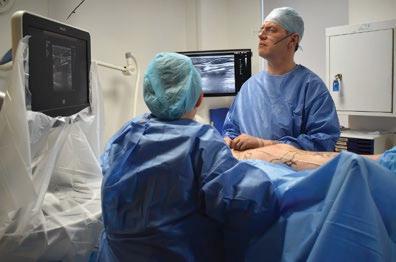
12 minute read
GO WITH THE FLOW

WORDS TOM OTLEY
















If you have varicose veins and travel frequently, you’d be well advised to get them checked – it could help to prevent you getting DVT


Go
flow with the


Deep vein thrombosis (DVT) can be a worry for frequent travellers. It occurs when altered blood ow leads to the formation of a blood clot in a deep vein of the leg. Symptoms include a swollen or painful calf or thigh. In uncommon cases, part of the clot moves to the lungs, causing a pulmonary embolism (blocked blood vessel) that, if severe, may cause the a ected lung to collapse. DVT isn’t caused only by travelling. Each year, it occurs in between one and three people per 1,000, according to the Department of Health, and, of those, only one in 100 cases is fatal. Nevertheless, frequent travellers may be more at risk than others. Professor Mark Whiteley, a consultant venous surgeon and phlebologist, explains why: “ e things that cause clots are the Virchow’s Triad [named a er German physician Rudolf Virchow]. ese are changes in the blood, changes in the blood ow and changes in the vessel wall. Any one of those can cause a clot.
“When you y, you have a change in the ow, since you’re just sitting there, so the blood isn’t owing as it should. You’re up in the air, so you have decreased oxygen and have changed the consistency of the blood. Finally, if you have varicose veins, then the vein wall is stretched and bulbous, allowing blood to clot on this altered vein wall. So when you y, you’ve got the perfect storm for DVT.”
RISK FACTOR
Our 2019 article on this (see businesstraveller.com/ feature-category/smart-traveller) dealt with some of the practical ways to guard against DVT, such as staying hydrated, moving regularly on the plane and wearing compression socks. e publicity around these measures has probably saved many people who would have su ered from DVT from having serious problems. ere’s no doubt, though, that some of us are more at risk than others, and so if you have varicose veins it would be a good idea to see a specialist.
Whiteley points out that a signi cant proportion of the population is unaware that they have varicose veins, as not all are visible on the surface. “Venous disease a ects around 30-40 per cent of people, and of that 30-40 per cent, only 15-20 per cent of people know they have got problems with their veins, because they can see them. e others are hidden under the skin’s surface,” he says.
“Whether they are visible or not, most vein disease will cause aching and painful legs and can lead to swollen ankles and, ultimately, can go on to cause leg ulcers and clots. Yet even in those cases, if you go to the doctor you will o en be given leg stockings or steroid treatments, neither of which really work because they don’t x the underlying problem.”
For those people who do have veins that show, who have su ered from leg ulcers or super cial vein thrombosis
(phlebitis), or who have a family history that might indicate problems are likely, Whiteley recommends having a pre-emptory scan.
DIAGNOSIS
“So it’s generally understood that if you have a clot in the deep veins, that’s bad because it can go to the lungs, and if you get a lump in the super cial, you don’t need to worry, because it’s just painful, and most doctors just give antibiotics.” Since my own varicose vein was visible, I thought it worth is more complex view was interesting, because that at least having a scan. My attitude towards undergoing advice was exactly what happened to a frequent-travelling surgery is that I have successfully avoided it all my life, and colleague of mine, who has twice su ered from a painful I intend to continue doing so. Nevertheless, a scan isn’t lump just underneath the skin a er ying long-haul. e painful, and at least then I could make an rst time he was prescribed antibiotics, the second time he informed decision. So it was that I found What we know was given a scan and some anticoagulants (medicines that myself having an initial consultation with Whiteley at his clinic just o London’s is that if the clot help to prevent blood clots). “If something is hot and red, doctors tend to reach for Oxford Street (he also runs clinics in is within 5cm of antibiotics,” Whiteley says. “But if you got punched in Guildford and Bristol). e scan, performed by a highly trained technologist, was extremely thorough – but a junction to the deep vein, it can the nose it would be hot and red and you wouldn’t give antibiotics. It is the irritation of the clot that causes a hot, red area because the body is trying to heal. then, in many ways, it is the most important turn into a DVT “Instead, there are two things that should be done. e part of the treatment. e scan should latest guidance from the British Committee for Standards ensure that every problematic vein, whether in Haematology and the American College of Chest visible or not, is identi ed, and also help the surgeon to Physicians Evidence-Based Clinical Practice Guidelines decide on what sort of treatment will be appropriate. since 2012 is to come and have a scan. What we know is e duplex scanning technique used that if that clot is within 5cm of a junction to the deep is, in fact, a threefold process (it’s called vein, it can turn into a DVT.” “triplex scanning” in some parts of the world). Worryingly, Whiteley says that these guidelines show It starts with a greyscale/B-mode ultrasound that about 1 per cent of people who have a clot in the scan that is similar to the standard kind used super cial veins for pregnancy. that is close to the en there is a “Doppler ultrasound” scan, junction end up beamed into the speci c area of the body and with a clot in their capable of being directed inside the vein. By combining lungs. “Yet doctors the ultrasound picture generated with the speci c are still giving Doppler waveform, this can be used to measure blood ow non-steroidal in the vein. anti-in ammatories
“ e third part of the scanning process is the colour and aspirin to ow/colour-coded element,” Whiteley explains. patients and telling “Computers these days are so fast that any movement them to put a on the black and white ultrasound picture can be stocking on. If it’s picked up and ‘coded’ as either blue or red depending on close to a deep vein, the direction of ow. is means we can see blood ow they must get a scan in a vein in real time and judge whether blood ows up and then be o ered an anticoagulant.” (I have advised my the vein normally and down abnormally, if the valves are colleague to go for a scan. We shall see.) not working.”
All of this is then brought together so that a bespoke treatment can be suggested to the patient. In my case, apart from some aching, the vein had never bothered me, but the scans showed that as well as the visible vein, there were other, deeper problems. Of course, as with all medical matters, the moment you are told that something a ects you, then it’s time to start researching, initially on Google, then ringing friends who have absolutely no specialism in the area you are asking about but who try to be helpful, and, nally, listening to the specialist in front of you.
“In the UK, we get taught that there are only two layers ABOVE RIGHT: of veins: deep in the muscle and super cial. is is wrong Ultrasound scanning can help to detect and there are in fact three layers,” Whiteley says. any problems
TREATMENT
So what was the advice for me? Would it be necessary to have the veins removed (or stripped, as I’ve heard it called, normally with a wince)? ankfully not. “In the UK, we still have some people having their veins stripped out, but it’s pointless because they almost always grow back, and grow back without valves, which means the problem has returned,” Whiteley says. “We did a study showing that at eight years [a er treatment], 82 per cent of those who had their veins stripped had grown their veins back again. e latest research shows you also get smaller new veins developing as well, making it more di cult to treat.” →

He says that, instead, it is better to destroy the veins with heat directed at the vein wall so that the cells undergo a process called apoptosis. e trick is to use a combination of techniques. Traditional treatment used radiofrequency ablation, but that only treats the vein it is touching; therefore, if the vein wall bulges away from the radiofrequency device, or there is a clot or scar in the vein, stopping it from being in contact during the treatment, then treatment could fail.
A high proportion of treatment now is by laser, but Whiteley says: “Saying ‘laser’ is like saying ‘car’. ere are many di erent types of laser, just as there are many di erent sorts of cars.” Sonovein is one of the latest techniques to treat veins, beaming ultrasound through the skin, burning tissue only in a very focused way.
Unfortunately, my veins were too extensive and too long for this, so it was decided that I would have another new treatment called microwave ablation. is is the same technique that Whiteley used on DJ and presenter Chris Evans in 2019, which Evans showed o in the press.
Once the correct combination of techniques was decided on, it was time to book the day for the treatment. In fact, it only took an hour, and was done under local anaesthetic. While this was uncomfortable, being awake is necessary so you can advise on levels of discomfort as the microwave kills o veins. Being able to feed back to the surgeon prevents overheating and burns. is protects the skin and nerves and is why modern vein surgeons should never use general anaesthetic or sedation.

PREVENTING REGROWTH
A erwards, my leg was encased in tight bandages and I rested for 30 minutes before walking out of the surgery, into a waiting Uber and o to the train station and home. ree days later, the bandages were o and I could see a transformed, if heavily bruised, leg. Twelve weeks later, I returned for the next stage of the treatment – foam.
“Once your leg has had the veins removed, there are only three reasons why the vein should come back,” Whiteley says. “First, you haven’t had the right ones treated; second, you had the right veins treated but with the wrong technique – so maybe laser but the wrong power; or, third, new veins have opened up. is last part can be reduced by foam sclerotherapy.”
Ultrasound-guided foam sclerotherapy is used because any bulging surface veins that have been removed during the procedure will try to regrow again. e foam stops them from growing back.
The microwave ablation treatment
only took an ankfully, the foam procedure hour and was done under local was not painful at all, and took less than an hour. My leg was then bandaged and a long stocking put anaesthetic over it. I had to keep it wrapped up for three weeks, which was irritating for the rst day or so but soon seemed normal. During this time, I took several long-haul ights, including a week-long trip to Hong Kong, and su ered no ill e ects. In fact, I just made sure to put a stocking on the other leg, for safety’s sake, even though there were no problematic veins on that one. For showering, I had a long plastic cover called a Limbo that was very e ective. Finally, a er three weeks of being bandaged up, my new leg was unveiled, free of varicose veins and ready to take its place in the world of short trousers without any unsightly bulges. is combination of vanity and concern for health could be life-saving, according to Christopher Ogden, a consultant uro-oncologist and pioneer of robotic surgery in the UK, who attended a recent Business Traveller event at London’s Bupa Cromwell Hospital. Ogden advises prioritising mental health up until the age of 50 and therea er concentrating on physical health, with health screenings for cardiovascular disease and cancers of the prostate and colon. For those su ering from painful veins, especially those who travel frequently, I would advise having a general MOT to discover potential problems, and considering having them xed. With luck, we are looking at longer lives, and treatments such as those for varicose veins can TOP RIGHT: Professor help to ensure a more comfortable duration. Mark Whiteley at work thewhiteleyclinic.co.uk










